Want to Improve the Performance of Sales Teams Using Salesforce?
We’ve helped multiple small businesses and large companies optimize Salesforce and adapt it to their teams’ needs.
Understanding Salesforce opportunity stages is key to successfully managing sales in your Salesforce CRM. With them, you can track the progress from the first contact with a lead to closing the deal with a customer. As an opportunity moves through the pipeline, the chance of winning the deal increases.
Tracking Salesforce opportunity stages helps sales teams know what actions are needed to close deals successfully in less time. Clearly defined and properly customized opportunity stages in Salesforce improve efficiency and solve a lot of sales challenges.
In this article, we will explain what an opportunity in Salesforce is, and how to create an opportunity in Salesforce, and will guide you through all the intricacies of sales opportunity stages in Salesforce.
In Salesforce, an opportunity represents a potential sales deal in progress. The Opportunity object is utilized to track all the details about the deal, such as:
Opportunities in Salesforce are essential for tracking and managing sales pipelines, as they provide visibility into sales activities, forecast revenue, and help sales teams assess the effectiveness of the current pipeline, therefore, closing more deals successfully.
Salesforce stages of opportunity are the phases that a sales deal goes through from the initial contact to its closure.
The opportunity stages in Salesforce can have statuses like Prospecting, Pledged, or Closed/Won, for instance. The sales opportunity stages can be customized to reflect the business sales process.
The essential functionalities and features of Salesforce sales stages are:
These key features support sales teams in managing their pipelines more efficiently, making informed decisions, and ultimately increasing their chances of closing deals.
The default Salesforce Opportunity stages are:
You can access default Salesforce stages of opportunity by navigating to:
Setup > Object Manager > Opportunity Object > Fields & Relationships > Stage
Here’s the detailed walkthrough on where to find Salesforce opportunity stages:
Step #1: Navigate to the setup page by clicking on the gear icon and then ‘Setup’.
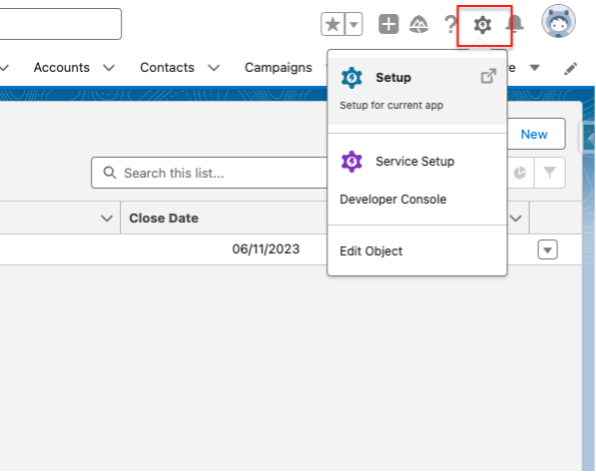
Step 1: Find ‘Setup’ Icon to Add an Opportunity Stage in Salesforce | Ascendix
Step #2: Select the ‘Object Manager’ tab and search for the ‘Opportunity’ object.

Step 2: Select the Object Manager Tab to Find Opportunity Object in Salesforce | Ascendix
Step #3: Click on the ‘Fields & Relationships’ tab and search for the ‘Stage’ field.
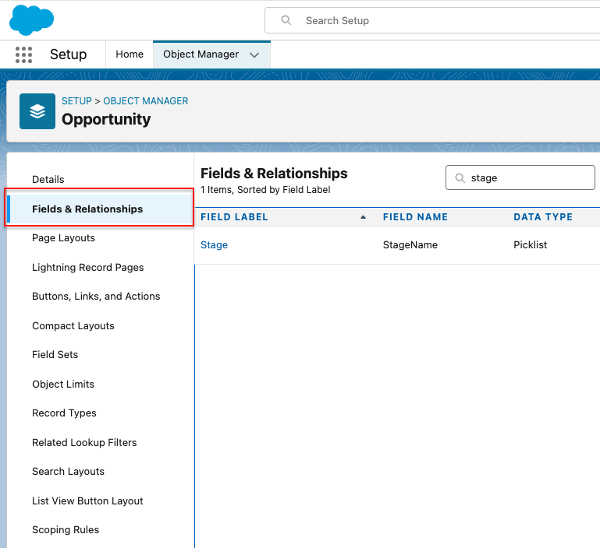
Step 3: Find the ‘Fields and Relationships’ Tab and Search for the ‘Stage’ Field in Salesforce | Ascendix
Once on this page, you can scroll down, and you will be able to see all active and inactive Salesforce Opportunity stages.
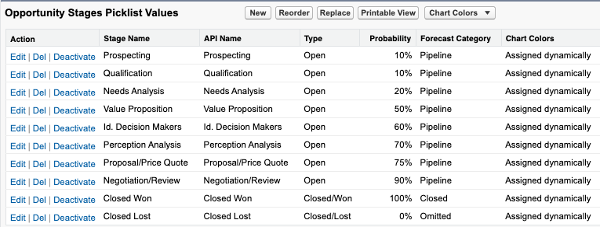
Where to See All Active and Inactive Opportunity Stages in Salesforce | Ascendix
We’ve helped multiple small businesses and large companies optimize Salesforce and adapt it to their teams’ needs.
Step #1: Navigate to the ‘Stage’ field tab and click on the ‘New’ button:

Where to Start to Create a Custom Salesforce Opportunity Stage | Ascendix
Step #2: In the field opened, fill in the required details about your new custom opportunity stage in Salesforce:
Description: This information doesn’t show up on the opportunity page and its goal is to facilitate system maintenance in the future.
Step #3: After inserting all the information, click ‘Save.’ A new Salesforce opportunity stage is now available.
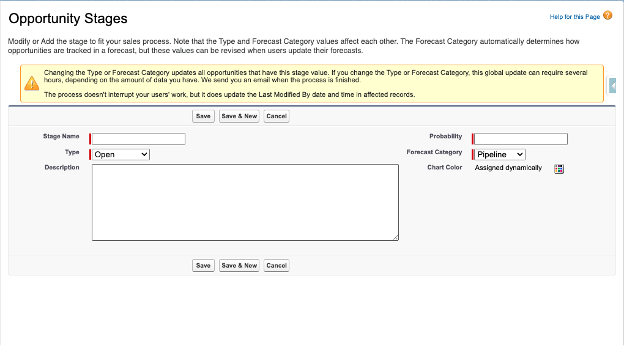
What Values Should Be Added to Create an Opportunity Stage in Salesforce | Ascendix
It’s also possible to reorder the Salesforce sales stages by going back to the previous page and hitting the ‘Reorder’ button.

How to Reorder Opportunity Stages in Salesforce | Ascendix
You can track Salesforce opportunity stages progress by using the Salesforce reporting feature together with the Opportunity history object.
This allows you to see how the opportunities progress through the pipeline.
Anytime a user changes the Amount, Probability, Stage, or Close Date fields on an opportunity, a new entry is added to the Stage History.
With this data, it is possible to analyze how long it takes to move opportunities through each stage.
To create such reports in Salesforce, follow the instructions below:
Step #1: Navigate to the ‘Reports’ tab and click ‘New Report’:

How to Create a New Report in Salesforce | Ascendix
Step #2: As the report type, you need to select ‘Opportunity History’ and then click ‘Start Report.’

Step 2: Select ‘Opportunity History’ and Click ‘Start Report | Ascendix
Step #3: Here you can play around with the filters and choose what fields should be shown in the table.

Step 3: Select Fields to Be Shown in a ‘New Opportunity History’ Report in Salesforce | Ascendix
You can track historical trends on opportunities utilizing the ‘Historical Trending’ feature.
It shows the changes between five snapshot dates, such as five business days or five business weeks. ‘Historical Trend Reporting’ in Salesforce for Opportunity stages can help your organization identify any possible delays in pipeline progression.
To enable such a feature, you will need to follow these steps:
Step #1: Go to ‘Setup‘ and search for ‘Historical Trending’ on the ‘Quick Find’ search bar and select it.
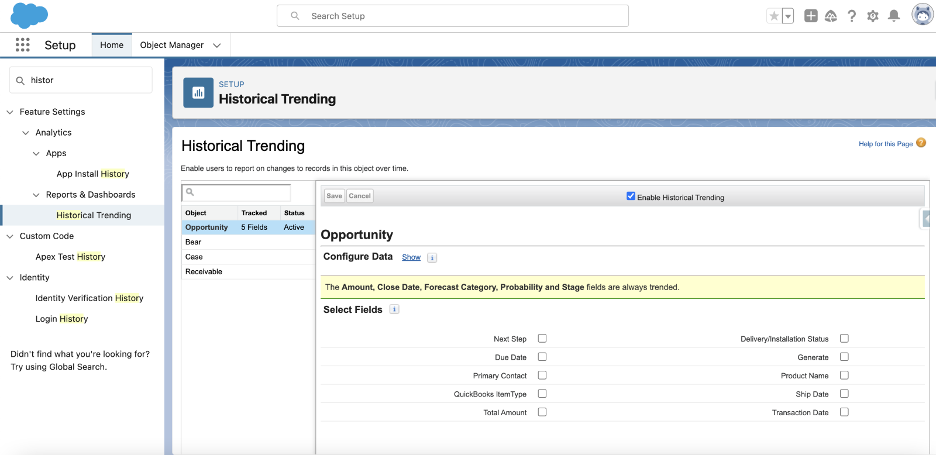
Where to Find Historical Trending in Salesforce | Ascendix
Step #2: Click on the ‘Enable Historical Trending’ checkbox.

How to Enable Historical Trending in Salesforce | Ascendix
Step #3: Once you enabled it, you will be able to create reports of the type ‘Opportunities with Historical Trending.’
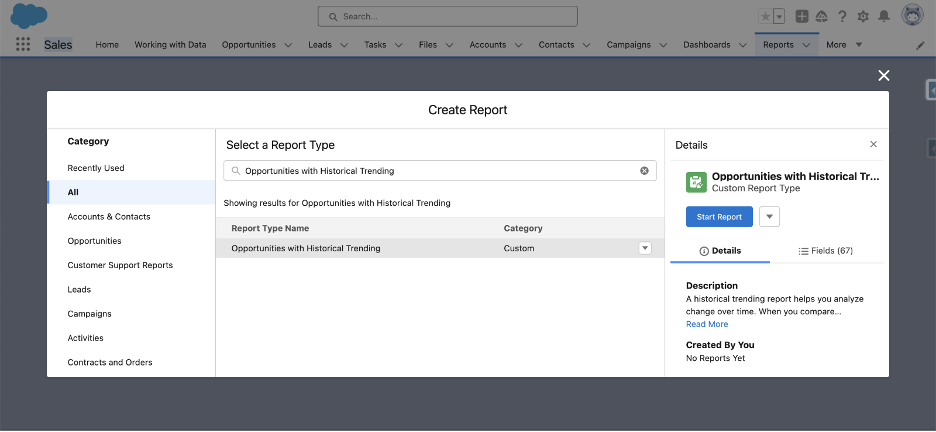
How to Create an ‘Opportunities with Historical Trending’ Report in Salesforce | Ascendix

How ‘Opportunities with Historical Trending’ Report in Salesforce | Ascendix
We have 20+ years of experience in Salesforce customization, configuration, and best custom development practices.
SFDC Opportunity Stages Duration Report. Using the Opportunity History report type you can measure how much time the opportunity stays on each stage. This information is provided with the Stage duration field and is represented in days.
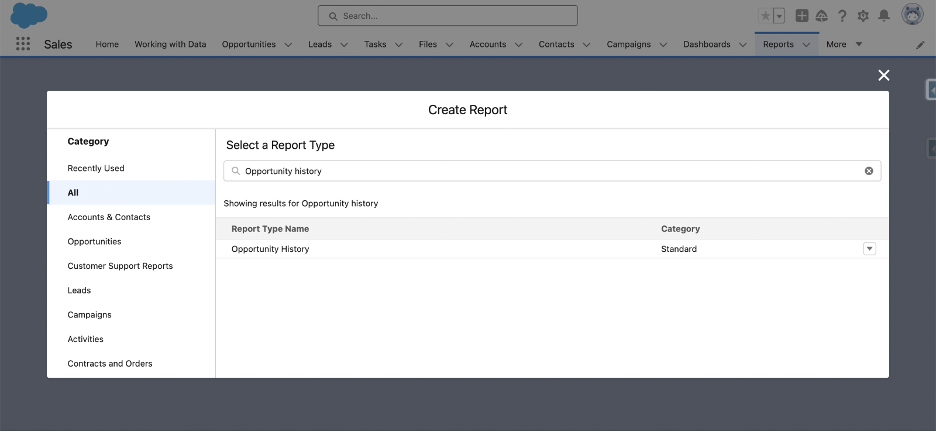
How to Create a New Opportunity History Report in Salesforce | Ascendix

Salesforce Opportunity Stages Duration Report | Ascendix
Salesforce Opportunities Stages Report. Utilizing this report, you can visualize how many opportunities there are in each stage, especially with the help of the funnel chart.
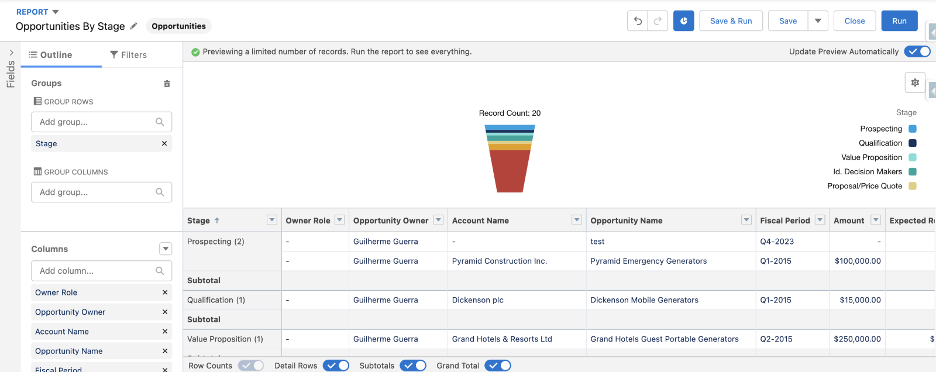
Salesforce Opportunities Stages Report | Ascendix
Learn more on how to:
Knowing how to use Salesforce opportunity management tools is only a part of the job. You must also understand why they are used and what business processes are enhanced by them.
To ensure this, follow the guidelines and best practices of Salesforce opportunity stages management:
We are sure that by following these guides and the best practices of Salesforce opportunity stages management you will increase your sales team’s efficiency and enhance your sales process.
Simplify your Salesforce experience by letting our experts tackle your Salesforce challenges.
The Ascendix Salesforce consultancy team can assist you in customizing Salesforce reports and dashboards, providing your team with quick access to critical data, and conducting thorough Salesforce audits to maximize your system’s potential.
Based in Dallas, Texas, Ascendix Technologies is a certified consultancy specializing in Salesforce and AppExchange app development.
As a Salesforce Crest Consulting Partner, our team boasts over 120 Salesforce certifications, proving our extensive expertise in the Salesforce ecosystem.
Book a free Salesforce consultation call with our experts. Start optimizing your Salesforce investment today!
To create new opportunities in Salesforce:
To change sales opportunity stages in Salesforce:
This update will reflect the new status of the opportunity within your Salesforce sales pipeline.
The lifecycle of an opportunity in opportunity management begins with the creation of a new opportunity, typically starting at the Prospecting stage.
As the sales process progresses, the opportunity moves through various stages such as:
Each stage represents a step closer to closing the deal. The lifecycle finishes with either a Closed Won stage (a successful sale), or a Closed Lost stage (not secured deal).
Guilherme Guerra is a Salesforce software developer at Ascendix Technologies. He has spent more than three years specializing in Salesforce development and consulting, earning him both Salesforce Certified Administrator (SCA) and Process Automation certificates. Gui's skills and experience serve numerous businesses by helping them set up and customize Salesforce, making the most of its capabilities.
Follow us and get expert insights and guides right to your inbox.